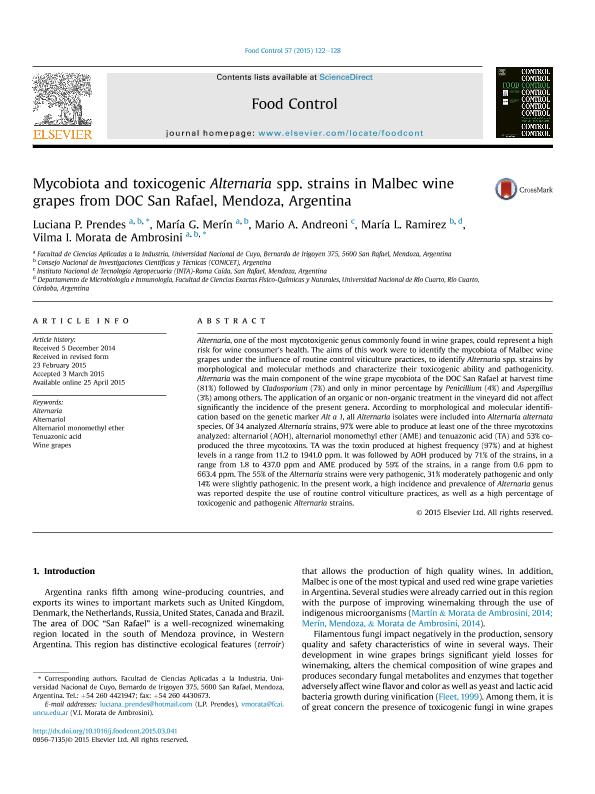Mostrar el registro sencillo del ítem
dc.contributor.author
Prendes, Luciana Paola

dc.contributor.author
Merín, María Gabriela

dc.contributor.author
Andreoni, Mario A.
dc.contributor.author
Ramirez, Maria Laura

dc.contributor.author
Morata, Vilma Ines

dc.date.available
2022-12-05T15:38:10Z
dc.date.issued
2015-03
dc.identifier.citation
Prendes, Luciana Paola; Merín, María Gabriela; Andreoni, Mario A.; Ramirez, Maria Laura; Morata, Vilma Ines; Mycobiota and toxicogenic Alternaria spp. strains in Malbec wine grapes from DOC San Rafael, Mendoza, Argentina; Elsevier; Food Control; 57; 3-2015; 122-128
dc.identifier.issn
0956-7135
dc.identifier.uri
http://hdl.handle.net/11336/180196
dc.description.abstract
Alternaria, one of the most mycotoxigenic genus commonly found in wine grapes, could represent a high risk for wine consumer's health. The aims of this work were to identify the mycobiota of Malbec wine grapes under the influence of routine control viticulture practices, to identify Alternaria spp. strains by morphological and molecular methods and characterize their toxicogenic ability and pathogenicity. Alternaria was the main component of the wine grape mycobiota of the DOC San Rafael at harvest time (81%) followed by Cladosporium (7%) and only in minor percentage by Penicillium (4%) and Aspergillus (3%) among others. The application of an organic or non-organic treatment in the vineyard did not affect significantly the incidence of the present genera. According to morphological and molecular identification based on the genetic marker Alt a 1, all Alternaria isolates were included into Alternaria alternata species. Of 34 analyzed Alternaria strains, 97% were able to produce at least one of the three mycotoxins analyzed: alternariol (AOH), alternariol monomethyl ether (AME) and tenuazonic acid (TA) and 53% co-produced the three mycotoxins. TA was the toxin produced at highest frequency (97%) and at highest levels in a range from 11.2 to 1941.0ppm. It was followed by AOH produced by 71% of the strains, in a range from 1.8 to 437.0ppm and AME produced by 59% of the strains, in a range from 0.6ppm to 663.4ppm. The 55% of the Alternaria strains were very pathogenic, 31% moderately pathogenic and only 14% were slightly pathogenic. In the present work, a high incidence and prevalence of Alternaria genus was reported despite the use of routine control viticulture practices, as well as a high percentage of toxicogenic and pathogenic Alternaria strains.
dc.format
application/pdf
dc.language.iso
eng
dc.publisher
Elsevier

dc.rights
info:eu-repo/semantics/openAccess
dc.rights.uri
https://creativecommons.org/licenses/by-nc-sa/2.5/ar/
dc.subject
ALTERNARIA
dc.subject
ALTERNARIOL
dc.subject
ALTERNARIOL MONOMETHYL ETHER
dc.subject
TENUAZONIC ACID
dc.subject
WINE GRAPES
dc.subject.classification
Micología

dc.subject.classification
Ciencias Biológicas

dc.subject.classification
CIENCIAS NATURALES Y EXACTAS

dc.title
Mycobiota and toxicogenic Alternaria spp. strains in Malbec wine grapes from DOC San Rafael, Mendoza, Argentina
dc.type
info:eu-repo/semantics/article
dc.type
info:ar-repo/semantics/artículo
dc.type
info:eu-repo/semantics/publishedVersion
dc.date.updated
2022-12-05T10:47:30Z
dc.journal.volume
57
dc.journal.pagination
122-128
dc.journal.pais
Países Bajos

dc.journal.ciudad
Amsterdam
dc.description.fil
Fil: Prendes, Luciana Paola. Universidad Nacional de Cuyo. Facultad de Ciencias Aplicadas a la Industria; Argentina. Consejo Nacional de Investigaciones Científicas y Técnicas. Centro Científico Tecnológico Conicet - Mendoza; Argentina
dc.description.fil
Fil: Merín, María Gabriela. Universidad Nacional de Cuyo. Facultad de Ciencias Aplicadas a la Industria; Argentina. Consejo Nacional de Investigaciones Científicas y Técnicas. Centro Científico Tecnológico Conicet - Mendoza; Argentina
dc.description.fil
Fil: Andreoni, Mario A.. Instituto Nacional de Tecnología Agropecuaria; Argentina
dc.description.fil
Fil: Ramirez, Maria Laura. Universidad Nacional de Río Cuarto. Facultad de Ciencias Exactas, Fisicoquímicas y Naturales. Departamento de Microbiología e Inmunología; Argentina. Centro de Investigaciones Cientificas ; Facultad de Ciencias Exactas Fisicas y Naturales ; Universidad Nacional de Cordoba;
dc.description.fil
Fil: Morata, Vilma Ines. Universidad Nacional de Cuyo. Facultad de Ciencias Aplicadas a la Industria; Argentina. Consejo Nacional de Investigaciones Científicas y Técnicas. Centro Científico Tecnológico Conicet - Mendoza; Argentina
dc.journal.title
Food Control

dc.relation.alternativeid
info:eu-repo/semantics/altIdentifier/url/http://www.sciencedirect.com/science/article/pii/S0956713515002169
dc.relation.alternativeid
info:eu-repo/semantics/altIdentifier/doi/http://dx.doi.org/10.1016/j.foodcont.2015.03.041
Archivos asociados
